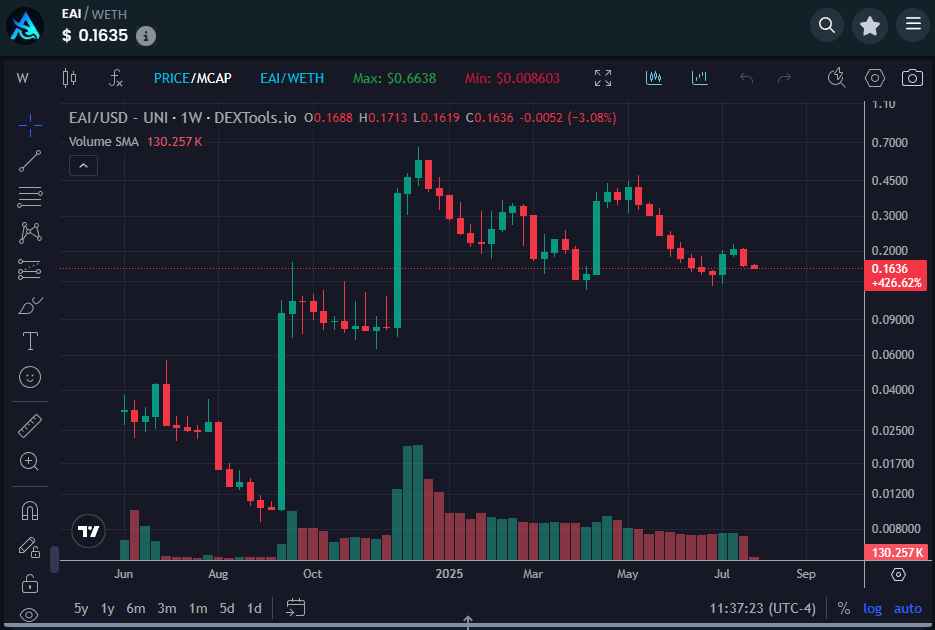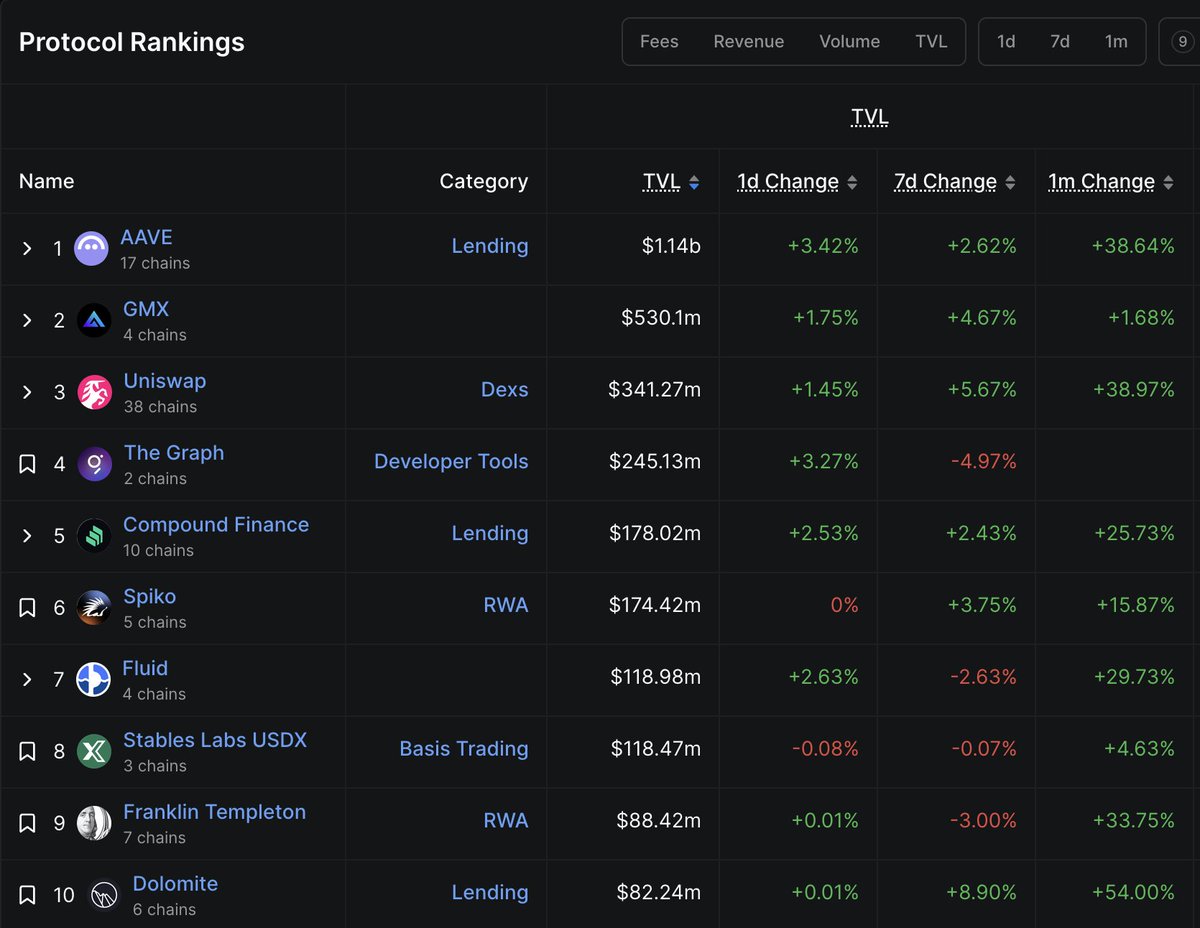Cours de Uniswap
en USD

À propos de Uniswap
Avis de non-responsabilité
Performance du cours de Uniswap
Uniswap sur les réseaux sociaux



Guides

Créez gratuitement un compte OKX.
Approvisionnez votre compte.
Choisissez votre crypto.
FAQ Uniswap
Plongez dans l’univers de Uniswap
Uniswap est une plateforme d'échange décentralisée, généralement appelée DEX, développée sur la blockchain Ethereum. Les traders utilisent Uniswap pourswap instantané de jetons ERC-20sans avoir besoin d'un marché liquide d'acheteurs, de vendeurs ou d'intermédiaires. Le réseau donne la priorité à la résistance à la censure, à la sécurité et à l'auto-détention, sans avoir besoin d'intermédiaires tiers.
Contrairement à une plateforme d'échange centralisée qui traite les ordres en interne via un carnet d'ordres, unla plateforme d'échange décentralisée exploite un teneur de marché automatisé (AMM), qui fonctionne comme un pool de liquidités constant et sans autorisation que les traders peuvent interagir directement sur la chaîne. UNI est le jeton natif du protocole Uniswap et peut être tradé sur divers marchés sur OKX. UNI est tenu de voter les propositions qui régissent le développement de la plateforme Uniswap. Vous pouvez également utiliser UNI pour créer des paires de liquidités et gagner des récompenses en cryptos.
L'écosystème Uniswap se compose des fonctionnalités suivantes :
- Uniswap Labs : la société qui a développé le protocole Uniswap.
- Le protocole Uniswap : un échange décentralisé de cryptomonnaies sur la blockchain Ethereum.
- L'interface Uniswap : une interface Web qui permet aux utilisateurs d'interagir avec le protocole.
- Uniswap Governance : un système de gouvernance qui utilise le jeton UNI pour régir le protocole Uniswap.
Bien que initialement développé pour le réseau Ethereum, Uniswap est désormais opérationnel surPolygon,Arbitrum, et les blockchains Optimism. Cette flexibilité inter-chaînes est l'une des choses que les utilisateurs de la finance décentralisée aiment à propos d'Uniswap.
Comment fonctionne Uniswap?
Uniswap est une plateforme d'échange décentralisée qui facilite la création d'une grande variété de pools de liquidités que les traders peuvent utiliser pour échanger des jetons. Tout jeton compatible peut être ajouté à une plateforme d'échange décentralisée et tradé sans qu'une entité centralisée ou une entreprise soit requise pour héberger la plateforme d'échange.
Pour activer cette option,Uniswap utilise des contrats intelligents, un utilitaire essentiel de la finance décentralisée, pour permettre aux traders d'échanger des jetons via un teneur de marché automatisé. Un teneur de marché automatisé, comme Uniswap, est un moyen d'échange qui permet aux traders d'échanger des cryptomonnaies dans des pools de liquidités sur la blockchain via l'application Web Uniswap. Lorsque les utilisateurs utilisent Uniswap, des facteurs externes tels que les heures d'ouverture du marché et la nécessité pour les autres traders de passer des ordres correspondants ne sont pas restreints.
Pour créer un pool de liquidités, un fournisseur de liquidités doit fournir deux jetons différents qui peuvent devenir un pot partagé de jetons avec lesquels les utilisateurs Uniswap peuvent trader. Le prix des jetons dans un pool de liquidité spécifique est réglementé par une formule mathématique qui détermine la valeur des jetons. Le trading avec un pool de liquidité modifie le ratio des jetons dans le pool, entraînant des changements dans le prix de chaque jeton.
Les frais de transaction incitent les fournisseurs de liquidités à approvisionner un pool de liquidités Uniswap en jetons. Ils reçoivent un pourcentage de chaque trade qui échange des jetons avec le pool. LesApplication décentralisée Uniswap (DApp)facilite la création d'une grande variété de traders de pools de liquidités qui peuvent être utilisés pour échanger des jetons. Tout jeton compatible peut être ajouté à Uniswap et tradé sans qu'une entité centralisée ou une entreprise soit requise pour héberger le marché.
Cours UNI et tokénomique
UNI est unJeton ERC-20 avec une offre en circulationd'environ 734 000 000 et un approvisionnement maximal de 1 000 000 000 jetons. Ces jetons seront distribués comme suit sur quatre ans :
- Membres de la communauté Uniswap : 60,00 % (600 000 000 UNI).
- Employés actuels et futurs : 21,266 % (212 660 000 UNI).
- Investisseurs : 18,044 % (180 440 000 UNI).
- Conseillers : 0,69 % (6 900 000 UNI).
15 % de l'approvisionnement UNI total ont été immédiatement mis à la disposition des « utilisateurs historiques et des fournisseurs de liquidités ». Cette opération a pour but de récompenser les premiers membres de la communauté pour leur confiance dans le réseau et dans les liquidités. De plus, 43 % des jetons UNI seront détenus par la trésorerie de gouvernance Uniswap. Ces 43 millions de jetons seront distribués grâce aux primes des contributeurs, aux initiatives de la communauté, au minage de liquidité et à d'autres programmes.
L'offre UNI est inflationniste, suivant un taux de 2 %, à partir de quatre ans après la frappe du jeton. Ce modèle inflationniste garantit une participation et une contribution continues au réseau Uniswap. La structure des émissions d'Uniswap indique que l'offre totale maximale sera atteinte en septembre 2024.
À propos du fondateur
Le développement du protocole Uniswap a commencé en 2017 lorsque le fondateur Hayden Adams a été renvoyé de sa fonction d'ingénieur technique chez Siemens. Adams a contacté son ami proche, Karl Floersch, qui lui a suggéré d'en apprendre plus sur Ethereum et les contrats intelligents. Pour développer ses compétences en codage et en apprendre plus sur la technologie blockchain, Adams a commencé à travailler sur un projet quiVitalik Buterin, le fondateur d'Ethereum, a décrit sur Reddit, un forum en ligne populaire.
Les missions de décentralisation et les protocoles d'autorisation l'ont poussé à poursuivre le développement de la plateforme Uniswap, bien qu'il soit actuellement sans emploi. Une avancée majeure s'est produite en avril 2018, lorsque Adams a été introduit à Vitalik Buterin lors de la conférence Deconomy à Séoul. Buterin a lu le code source d'Adam et lui a conseillé de demander une subvention de la Fondation Ethereum et de continuer à développer Uniswap dans Vyper, une autre langue de codage.
Après plusieurs mois de développement continu, la plateforme d'échange décentralisée Uniswap a finalement été déployée sur le mainnet Ethereum en novembre 2018. Toutefois, l'équipe ne s'est pas arrêtée là et, à ce jour, continue d'améliorer la plateforme avec des mises à jour fréquentes. L'un de ces niveaux est les frais de transaction facultatifs dans Uniswap v3. Cela permet aux fournisseurs de liquidités de choisir le nombre de traders dont ils ont besoin pour payer les frais de transaction lors du trading. Uniswap détient aujourd'hui la valeur totale verrouillée la plus élevée de n'importe quelle plateforme d'échange décentralisée sur Ethereum.plus grande blockchain de contrats intelligents de couche 1dans le secteur des cryptomonnaies.
À titre de premier plan dans ce domaine, Uniswap a attiré un intérêt important de la part de plusieurs investisseurs institutionnels connus. Des investisseurs de poids lourd comme Delphi Digital, Pantera Capital, a16z Crypto et Blockchain Capital ont soutenu et financé Uniswap. Ces fonds expérimentés ont contribué au développement d'Uniswap et contribuent de manière significative à son succès actuel.
Points forts d'Uniswap
NFT sur Uniswap
L'un des développements les plus passionnants et les plus abordés dans Uniswap est l'intégration de.un agrégateur de jetons non fongibles (NFT)sur la plateforme. En juin 2022, Uniswaps Labs a annoncé qu'ils avaient acheté du Génie et qu'ils l'appliqueraient sur le site Uniswap.
Genie est un agrégateur de NFT. Cela signifie que les acheteurs potentiels de NFT peuvent utiliser Genie pour collecter et acheter des NFT répertoriés sur n'importe quelle place de marché. Cela simplifie le processus de collecte des NFT et supprime la nécessité de consulter de nombreuses places de marché différentes pour les meilleures offres. Cela est une étape massive dans le développement du projet, et les utilisateurs de DeFi et les collecteurs de NFT sont très ravis d'Uniswap.
The Swap Widget
En avril 2022, le développement Uniswap a dévoilé et déployé Swap Widget, une fonction de swap que les développeurs peuvent facilement intégrer à leurs applications. Swap Widget permet aux utilisateurs d'échanger des jetons à partir d'un site tiers au lieu de naviguer sur l'application Web Uniswap. Swap Widget peut être ajouté à une dApp compatible via une seule ligne de code et est déjà utilisé par des sites populaires comme OpenSea.
Déclaration ESG




































